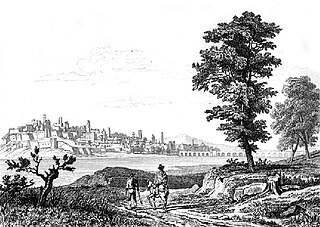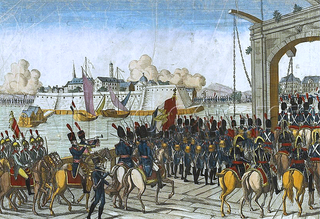
The Battle of Uclés saw an Imperial French corps led by Marshal Claude Perrin Victor attack a Spanish force under Francisco Javier Venegas. The French easily crushed their outnumbered foes, capturing over half of the Spanish infantry. Uclés is located in the province of Cuenca 15 kilometres (9.3 mi) east of Tarancón and 100 kilometres (62 mi) southeast of Madrid. The action occurred during what is called the Peninsular War in English-speaking countries and the Spanish War of Independence in Spain. The war was part of a larger struggle known as the Napoleonic Wars.

The Battle of Ocaña was fought on 19 November 1809 between French forces under Marshal Jean-de-Dieu Soult against the Spanish army under General Juan Carlos de Aréizaga, which suffered its greatest single defeat in the Peninsular War.

The Battle of Albuera was a battle during the Peninsular War. A mixed British, Spanish and Portuguese corps engaged elements of the French armée du Midi at the small Spanish village of Albuera, about 20 kilometres (12 mi) south of the frontier fortress-town of Badajoz, Spain.

The Battle of Talavera was fought just outside the town of Talavera de la Reina, Spain some 120 kilometres (75 mi) southwest of Madrid, during the Peninsular War. At Talavera, a British army under Sir Arthur Wellesley combined with a Spanish army under General Cuesta fought in operations against French-occupied Madrid. At nightfall, the French army withdrew a short distance after several of its attacks had been repulsed; the allies, having suffered comparable casualties to the French, made no attempt to pursue.

Antoine-Charles-Louis, Comte de Lasalle was a French cavalry general during the French Revolutionary and Napoleonic Wars. Often called "The Hussar General," he first gained fame for his role in the Capitulation of Stettin. Throughout his short career, he became known as a daring adventurer and was credited with many exploits, fighting on every front. He was killed at the Battle of Wagram.

The Battle of Orthez saw the Anglo-Spanish-Portuguese Army under Field Marshal Arthur Wellesley, Marquess of Wellington attack an Imperial French army led by Marshal Nicolas Soult in southern France. The outnumbered French repelled several Allied assaults on their right flank, but their center and left flank were overcome and Soult was compelled to retreat. At first the withdrawal was conducted in good order, but it eventually ended in a scramble for safety and many French soldiers became prisoners. The engagement occurred near the end of the Peninsular War.

The Battle of Golymin took place on 26 December 1806 during the War of the Fourth Coalition at Gołymin, Poland, between around 17,000 Russian soldiers with 28 guns under Prince Golitsyn and 38,000 French soldiers under Marshal Murat. The Russian forces disengaged successfully from the superior French forces. The battle took place on the same day as the Battle of Pułtusk.

The Battle of Cabezón was an engagement early in the Peninsular War on 12 June 1808 between Spain's Army of Castile, under Cuesta, based at Valladolid, and detachments of Marshal Bessières' French Army Corps under generals General Lasalle and Merle. Lasalle occupied Valladolid without opposition that same evening.

Louis Henri Loison briefly joined the French Army in 1787 and after the French Revolution became a junior officer. Blessed with military talent and courage, he rapidly rose to general officer rank during the French Revolutionary Wars. He got into difficulties because of his fondness for plundering. In late 1795 he helped Napoleon Bonaparte crush a revolt against the government. After a hiatus, he returned in 1799 to fight in Switzerland where he earned another promotion. In 1800 he commanded a division under Napoleon in the Marengo campaign.

Édouard Jean-Baptiste, comte Milhaud was a French politician and Général de Division. He distinguished himself throughout the French Revolutionary and Napoleonic Wars and is considered one of the best generals of cavalry of Napoleon's army.

The Battle of the Gebora took place during the Peninsular War between Spanish and French armies on 19 February 1811, northwest of Badajoz, Spain. An outnumbered French force routed and nearly destroyed the Spanish Army of Extremadura.

In the Battle of Maguilla a British cavalry brigade led by Major General John Slade attacked a similar-sized French cavalry brigade commanded by General of Brigade Charles Lallemand. The British dragoons scored an initial success, routing the French dragoons and capturing a number of them. The British troopers recklessly galloped after their foes, losing all order. At length, the French reserve squadron charged into the British, followed by the French main body which rallied. With the tables turned, the French dragoons chased the British until the horses of both sides were too exhausted for the battle to continue. The action took place during the Peninsular War, near Maguilla, Spain, a distance of 17 kilometres (11 mi) northeast of Llerena.

Jean-Pierre-Antoine Rey commanded a famous French infantry regiment during the Napoleonic Wars and became a general officer in 1808. He led an infantry brigade in a number of actions in Spain and France. His brother Louis Emmanuel Rey was a French general of brigade who also served in Spain during the Peninsular War. Since most sources do not distinguish between the generals named Rey, the two are easily confused.

In the Battle of Prenzlau or Capitulation of Prenzlau on 28 October 1806 two divisions of French cavalry and some infantry led by Marshal Joachim Murat intercepted a retreating Prussian corps led by Frederick Louis, Prince of Hohenlohe-Ingelfingen. In this action from the War of the Fourth Coalition, Hohenlohe surrendered his entire force to Murat after some fighting and a parley. Prenzlau is located about 90 kilometers north of Berlin in Brandenburg.

The Capitulation of Pasewalk on 29 October 1806 resulted in the surrender of Oberst (Colonel) von Hagen's 4,200 Prussian soldiers to an inferior force of two French light cavalry brigades led by Generals of Brigade Édouard Jean Baptiste Milhaud and Antoine Lasalle. The Prussians were completely demoralized after a two-week-long retreat following their decisive defeat at the Battle of Jena-Auerstedt. Pasewalk is 110 kilometers north of Berlin and about 40 kilometers west of Szczecin (Stettin), Poland.

In the Capitulation of Stettin on 29–30 October 1806, Lieutenant General Friedrich Gisbert Wilhelm von Romberg surrendered the garrison and fortress to a much smaller French light cavalry brigade led by General of Brigade Antoine Lasalle. This event was one of a number of surrenders by demoralized Prussian soldiers to equal or inferior French forces after their disastrous defeat at the Battle of Jena-Auerstedt on 14 October. Stettin, now Szczecin, Poland, is a port city on the Oder River near the Baltic Sea, about 120 kilometres (75 mi) northeast of Berlin.

The second siege of Badajoz saw an Anglo-Portuguese Army, first led by William Carr Beresford and later commanded by Arthur Wellesley, the Viscount Wellington, besiege a French garrison under Armand Philippon at Badajoz, Spain. After failing to force a surrender, Wellington withdrew his army when the French mounted a successful relief effort by combining the armies of Marshals Nicolas Soult and Auguste Marmont. The action was fought during the Peninsular War, part of the Napoleonic Wars. Badajoz is located 6 kilometres (4 mi) from the Portuguese border on the Guadiana River in western Spain.

The Battle of Arzobispo on 8 August 1809 saw two Imperial French corps commanded by Marshal Jean-de-Dieu Soult launch an assault crossing of the Tagus River against a Spanish force under José María de la Cueva, 14th Duke of Alburquerque. Alburquerque's troops rapidly retreated after suffering disproportionate losses, including 30 artillery pieces. El Puente del Arzobispo is located 36 kilometres (22 mi) southwest of Talavera de la Reina, Spain. The action occurred during the Peninsular War, part of a larger conflict known as the Napoleonic Wars.
Ramón Patiño, Count of Belvedere was a Spanish military commander during the Peninsular War.

Juan Díaz Porlier, also known as the "Marquesito", was a Spanish military commander active during the Peninsular War.




















